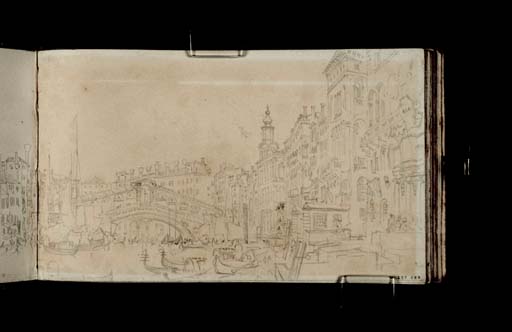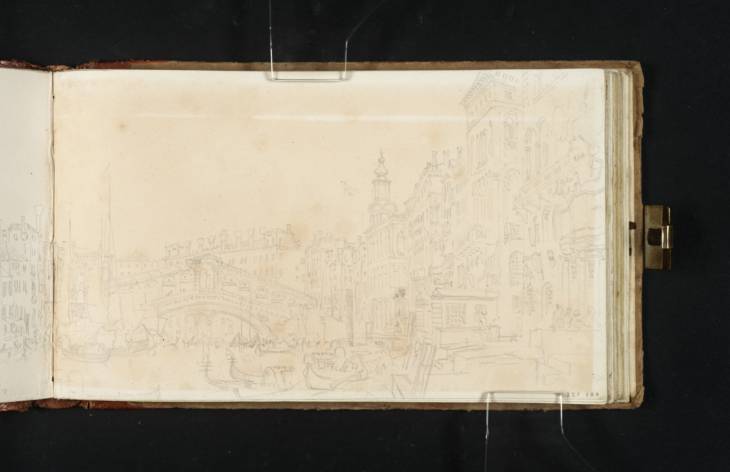Joseph Mallord William Turner The Grand Canal, Venice, with the Rialto Bridge from near the Albergo Leon Bianco (Palazzo Cavalli) 1819
Image 1 of 2
-
 Joseph Mallord William Turner, The Grand Canal, Venice, with the Rialto Bridge from near the Albergo Leon Bianco (Palazzo Cavalli) 1819
Joseph Mallord William Turner, The Grand Canal, Venice, with the Rialto Bridge from near the Albergo Leon Bianco (Palazzo Cavalli) 1819 -
 Joseph Mallord William Turner, The Grand Canal, Venice, with the Rialto Bridge from near the Albergo Leon Bianco (Palazzo Cavalli) 1819 (Enhanced image)Enhanced image
Joseph Mallord William Turner, The Grand Canal, Venice, with the Rialto Bridge from near the Albergo Leon Bianco (Palazzo Cavalli) 1819 (Enhanced image)Enhanced image
Joseph Mallord William Turner,
The Grand Canal, Venice, with the Rialto Bridge from near the Albergo Leon Bianco (Palazzo Cavalli)
1819
Joseph Mallord William Turner 1775–1851
Folio 48 Verso:
The Grand Canal, Venice, with the Rialto Bridge from near the Albergo Leon Bianco (Palazzo Cavalli) 1819
D14406
Turner Bequest CLXXV 48a
Turner Bequest CLXXV 48a
Pencil on white wove paper, 112 x 185 mm
Partial watermark ‘lee | 13’
Inscribed by Turner in pencil ‘[?Black]’ towards top right, on shield
Partial watermark ‘lee | 13’
Inscribed by Turner in pencil ‘[?Black]’ towards top right, on shield
Accepted by the nation as part of the Turner Bequest 1856
Exhibition history
1904
National Gallery, London, various dates to at least 1904 (602m, as ‘The Rialto, with the East Side of the Grand Canal’, one of ‘Twelve Leaves from a Book of Sketches at Venice’).
References
1904
E.T. Cook and Alexander Wedderburn eds., Library Edition: The Works of John Ruskin: Volume XIII: Turner: The Harbours of England; Catalogues and Notes, London 1904, pp.304 no.264, as ‘The Rialto, with the East Side of the Grand Canal’, 636 no.602, as one of ‘Twelve Leaves from a Book of Sketches at Venice’.
1909
A.J. Finberg, A Complete Inventory of the Drawings of the Turner Bequest, London 1909, vol.I, p.513, CLXXV 48a, as ‘The Rialto, with the east side of the Grand Canal. Exhibited Drawings, No.602m, N.G.’.
1930
A.J. Finberg, In Venice with Turner, London 1930, pp.33, 34, 46, 164, as ‘The Rialto from the corner of the Fondamenta Cavalli. The buildings on the right, from the foreground, are the Farsetti, Loredan, Enrico Dandolo, Bembo and Manin palaces. The tower of S. Bartolomeo rises immediately above the latter palace’, pl.VI, as ‘The Rialto from the Fondamenta Cavalli’.
1979
Andrew Wilton, The Life and Work of J.M.W. Turner, Fribourg 1979, p.383 under no.718.
1985
Lindsay Stainton, Turner’s Venice, London 1985, p.17, fig.4, as ‘The Grand Canal, looking towards the Rialto’.
1997
Inge Herold, Turner on Tour, Munich and New York 1997, reproduced p.46 as ‘The Grand Canal, looking towards the Rialto’.
2008
James Hamilton, ‘Turner e l’Italia’ in James Hamilton, Nicola Moorby, Christopher Baker and others, Turner e l’Italia, exhibition catalogue, Palazzo dei Diamanti, Ferrara 2008, p.42, fig.23 (colour), as ‘Il ponte di Rialto visto dell’albergo Leon Bianco’.
2009
James Hamilton, ‘Turner’s Route to Rome’ in Hamilton, Nicola Moorby, Christopher Baker and others, Turner & Italy, exhibition catalogue, National Galleries of Scotland, Edinburgh 2009, p.40, pl.45 (colour), as ‘The Rialto Bridge from the Albergo Leone Bianco’.
Inverted relative to the sketchbook’s foliation, the view is to the north-east along the Grand Canal, from the point where the Calle Cavalli runs off the waterside Riva del Carbon. The buildings on the north side are continued about half-way across folio 49 recto opposite (D14407), where there is also a separate continuation of the foreground shown here along the south side, as noted below.
Finberg subsequently annotated his 1909 Inventory entry (‘The Rialto, with the east side of the Grand Canal’): ‘Bldgs. from right, beginning with Pal. Farsetti (then Auberge de la Grande Bretagne), then P. Loredan, Enrico Dandolo, Bembo & Manin (just under Church tower)’.1 In his 1930 book In Venice with Turner he similarly noted the ‘Farsetti, Loredan, Enrico Dandolo, Bembo and Manin palaces. The tower of S[an] Bartolomeo rises immediately above the latter palace’,2 now known as the Dolfin Manin. Beyond the bridge is the Fondaco dei Tedeschi. Finberg observed that ‘even in this sketch, which was made primarily for the sake of the buildings, Turner gives precedence to the shipping. The boats with their sails on the left of the Rialto must have been drawn before the buildings which form their background were put in’.3 Presumably, with limited time and much to record in Venice, Turner was not at leisure to wait for vessels to move on and leave a clear view of the buildings beyond.
The small waterside pavilions in front of the Loredan do not survive, while the lower part of the Farsetti’s façade now comprises a more regular sequence of arches than Turner recorded.4 Beyond the outer edge of the page in the immediate foreground to the right would be the Palazzo Cavalli (or Corner Martinengo Ravà), then the Albergo Leon Bianco, where Turner was staying on this first visit to Venice;5 it is now a civic building. The Route to Rome sketchbook Turner carried with him on this tour includes travel notes by James Hakewill (see below). Before listing various places and pictures to see, Hakewill noted: ‘Venice – Go to the Leone Bianco | on the grand Canal’ (Tate D13903; Turner Bequest CLXXI 24). As Finberg noted (see above), the Ca’ Farsetti was also a hotel at that time, known as the Auberge de la Grande Bretagne or Albergo Gran Bretagna;6 within a few years it had been acquired by the city,7 and is now a registry office.8 The signage apparently then at its near end is recorded as a separate detail inverted on D14407 opposite, along with the north-east corner of the Leon Bianco.
Before arriving in Venice, Turner was already very familiar with the general arrangement of this very view, having made a watercolour of it (currently untraced)9 engraved in 1820 for James Hakewill’s Picturesque Tour of Italy (Tate impression: T06012; for the project in general, see Nicola Moorby’s overall Introduction to the tour) as The Rialto, Venice. This was derived from Hakewill’s own adequately detailed if basic 1817 outline drawing made with an optical device, apparently from the higher viewpoint of a Leon Bianco balcony, which Turner traced and tinted with rudimentary ‘colour beginning’-type washes (Tate D32144; Turner Bequest CCCXVI 7), developing a composition with a fanciful cast of characters and some spurious architectural details.10
Discussing the Hakewill-derived view, Finberg imagined that Turner ‘chuckled quietly over the many trifling differences between the real thing and the water-colour he had made of it’.11 Like his numerous other Grand Canal sketches, made from a low boat or adjacent quays and landing stages, Turner’s is from much closer to the surface of the water. Perhaps to avoid awkward comparisons which the notionally accurate Hakewill version, he did not make a watercolour from his own memorandum, choosing instead to use another double-page drawing looking in the same direction from nearly twice as far westwards, thus encompassing the elements here in less detail in a wider context (Indianapolis Museum of Art);12 see under folios 73 recto and 74 recto (D14455–D14456) which, like this page and D14407, ought to be bound as a continuous view. Folios 74 verso–75 recto (D14457–D14458) again show the bridge and the buildings each side, but from about half the distance compared to the present view.13
See under folio 69 verso (D14448) for an unrelated Hakewill-based subject.
Undated MS note by A.J. Finberg (died 1939) in interleaved copy of Finberg 1909, Tate Britain Prints and Drawings Room, I, opposite p.513.
Hamilton 2009, p.40, appears to conflate the two, noting the ‘Albergo Leone Bianco, which [Turner] described beside a sketch of part of the building [D14407], as “The Inn of Great Britain”’ as ‘now the City of Venice Registry of Births, Marriages, Divorces and Deaths’.
See Warrell 2003, pp.49–50 and figs.31, 29, 30 (respectively the engraving, Hakewill’s drawing and Turner’s outline).
Technical notes:
The page is darkened, having formerly been extracted from the sketchbook and subjected to prolonged display, except where the edges were protected by a mount.
Matthew Imms
March 2017
How to cite
Matthew Imms, ‘The Grand Canal, Venice, with the Rialto Bridge from near the Albergo Leon Bianco (Palazzo Cavalli) 1819 by Joseph Mallord William Turner’, catalogue entry, March 2017, in David Blayney Brown (ed.), J.M.W. Turner: Sketchbooks, Drawings and Watercolours, Tate Research Publication, July 2017, https://www

